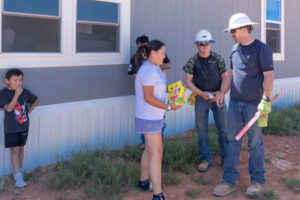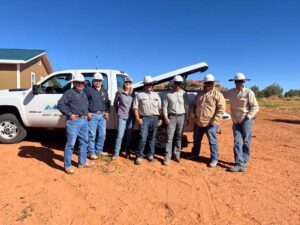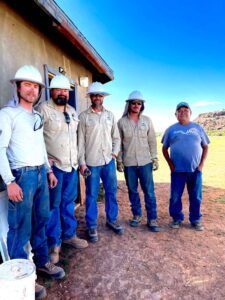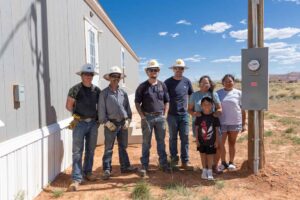Volunteer Linecrews Light Up Navajo Nation
Rock formations dot the beautiful landscape on the remote drive to Chinle, Arizona, along Highway 191. Mesas, buttes, and red chimney-shaped pillars stand tall and provide landmarks across Navajo Nation.
Spanning more than 27,000 square miles across the southwestern United States, Navajo Nation covers land in Arizona, New Mexico, and Utah. The elevation ranges from 6,000 to 7,000 feet above sea level, and the area can experience heavy winters from November to April.
I’ve always loved what I do, restoring power to people’s homes. But to build a power line to someone who has never had power at their home is something special.” — Mountain Parks Electric Apprentice Lineman Isiaih Herod
Out of approximately 400,000 Navajo citizens, about 186,500 live on Navajo Nation. More than 13,000 families living on Navajo Nation do not have basic access to electricity at home. Refrigeration of fresh food is a constant challenge. Thousands of families haul water at least three times each week — often driving more than 20 miles one way. And thousands more rely on chopped wood and coal for heating and cooking.

Light Up Navajo is an initiative to change those statistics and to change people’s lives. It was started by the Navajo Tribal Utility Authority and is a partnership with the American Public Power Association. Since 2008, NTUA has connected 7,778 families’ homes to receive electricity. And as of June 20, 2024, the homes of 125 more Navajo families have been connected to the grid for the first time. The goal of 2024’s Light Up Navajo V is to connect at least 150 homes. To achieve this, 250 electric lineworkers from more than 40 utilities across 16 states volunteered to help connect homes to the grid.
In June and July, seven Colorado electric co-ops were invited to Navajo Nation areas including Chinle, Fort Defiance, Kayenta, Dilkon, Tuba City, and Shiprock. The volunteer crews traveled to assist Navajo Tribal Utility Authority crews to set poles, string power lines, and install electric meters at homes.
OVERCOMING CHALLENGES NTUA’s
Chinle district is in central Navajo Nation and has the second-largest NTUA customer base.

Association CEO Ruth Marks, and MVEA linecrew members Levi
Suarez, Jon Weitz, John Webb, and Nathan Ortiz.
Janice Harvey leads the project team at the Chinle district office. She explained that the biggest impact of the LUN initiative is that kids are getting access to charge their laptops for school. At the start of the pandemic, she continued, NTUA’s motivation was helping schoolkids switch to remote learning. “Some kids didn’t have electricity in the home, and they had a bigger challenge in learning,” Janice said. “They didn’t have Wi-Fi that they could connect to for virtual learning. It set our kids back, and there was a lot of learning lost during that time.” Early in the pandemic, NTUA set up hot spots at district offices for schoolkids, so they could come sit outside and use the Wi-Fi for school.

Some NTUA applicants have been waiting years for electricity. Challenges in getting electricity to these homes and families include infrastructure limitations, supply chain issues, and siting and permitting with archaeological and environmental considerations.
“The process to get electric not only involves NTUA,” Janice said. “When customers come in to apply, they’ve done a lot of prep work obtaining their homesite lease and building their structures. We don’t have the resources of archaeologists, we don’t have the resources of environmentalists or biologists, so we have to find those contractors outside of Navajo Nation.”
After a customer applies, Janice said NTUA has to acquire a service line agreement, which is an approval from the Navajo Nation Land Department to build infrastructure. This legwork can be extremely time consuming. But the positive impact when people finally get electricity is immeasurable. They gain food refrigeration, light at night, electric cooking, and home heating and cooling. Janice, who has been with NTUA for eight years, explained that when families get electricity at their homes, it also opens the door to getting access to other utilities, including water and broadband.
MELISSA’S HOUSE
Melissa bought her home one year ago and has waited that long to get it connected to the grid. For the past year, she and her kids — Carter and Malia — have lived with Melissa’s parents.
Back in Chinle in June, a linecrew from Granby-based Mountain Parks Electric got to work early one morning to set a power pole. Working like a game of connect-thedots, by midmorning they had set a second pole about 100 yards down the red dirt road to connect the power line to the pole that was already placed next to the home.

After a lunch break — and as temperatures reached 90 degrees — the crew returned to connect the new poles and power lines to the transmission lines running along the highway at the end of the driveway.
Around 4 p.m., Mountain Parks Electric Apprentice Lineman Isiaih Herod installed the home’s electric meter and flipped the breaker. NTUA Crew Foreman Julius Yazzie knocked on the door of the home and went inside to make sure everything was in working order and that electricity was flowing to outlets and appliances.
The family came outside with bright smiles on their faces.
Melissa invited the crew to cool off with Popsicles, cold drinks, and fruit from the cooler in the back of her truck. Carter talked about his recent baseball game, and Malia took it all in. Melissa, a single mom who works at a Head Start preschool one hour away, said she was excited to start moving into the newly electrified house that weekend.
The crew from Mountain Parks Electric served six families during their volunteer week and brought the gift of electricity. The crew benefited from the experience, too. “It was really humbling,” Isiaih said. “I’ve always loved what I do, restoring power to people’s homes. But to build a power line to someone who has never had power at their home is something special.”
GATHERING IN APPRECIATION
The evening Melissa’s house was connected, she and the other NTUA customers whose homes were also connected to the grid that week gathered for fellowship and a steak dinner cooked and served by NTUA’s Chinle district staff.
Janice facilitated the dinner and was proud to announce that during the first five weeks of LUN V, crews in Chinle completed 26,259 feet of electric line, which equates to 4.97 miles. “We’re glad that we got help from volunteers to work alongside our own crews to help extend lines to our customers,” Janice said.
MPE Crew Foreman Chase Gaines reflected on his time working in Chinle. “We often take for granted the amenities that we have living where we do,” he said. Chase grew up near Navajo Nation in New Mexico and noticed all the towns close to the highway had power. But traveling to Chinle, he was surprised to learn how many people are still without power. “I guess I never paid attention to how many homes there could be close to town that didn’t have power lines built to them — not to mention all the people who live off the beaten path.”
MPE Apprentice Lineman Bryce Poppe said, “The Light Up Navajo experience was very rewarding. I hope I get the opportunity to go back again.”
At the dinner, the new NTUA customers each had an opportunity to thank the crews in person. There were tears of joy and gratitude all around the room as people explained what getting electricity at their home means to them.
ELAINE
“I’m originally from Window Rock. I was raised without electricity, without running water. It made me who I am today. I had to do homework and beat the sun to get things done. I was fine with that. I was happy with that. It made me a strong, tough woman and kept me out of a lot of trouble.
But once I had my kids, it was tough. We got our home — a single-wide trailer — when I was pregnant with our son. The home was delivered during COVID time, and so there was no one working on anything. Everything came to a halt — our entire world came to a halt.

We learned how to deal with it. The hard part for me was watching my kids endure the summer heat and layering them up with clothes during winter because we didn’t have electricity. We had a woodstove, and I am really appreciative of the lifestyle that we lived for a while. It’s a beautiful home, but we couldn’t enjoy the luxuries of watching TV or having a refrigerator.
We could have gone elsewhere. We could have chosen somewhere else to live, like in the city or closer to town. But I really wanted to preserve our culture, our way of life, by raising our kids next to the sheep corral, the horse corral. I wanted them to experience living on Navajo Nation, and I didn’t want to leave. It’s a beautiful place.
Once I saw you coming through our gates earlier this week, my heart was really, really pounding. I was really happy putting up the welcome signs for you to let you know you were in the right place.
This was four and a half years in the making, and I’m really glad that you guys took time away from your family and home to come help us and to be with us for a while. From my family, my home, my husband, my grandma, my grandpa, I thank each and every one of you guys for doing this for me, for my community, my people. If it wasn’t for your help, we would have had to wait a little bit longer.
This was four and a half years in the making, and I’m really glad that you guys took time away from your family and home to come help us and to be with us for a while. From my family, my home, my husband, my grandma, my grandpa, I really thank each and every one of you guys for doing this for me, for my community, my people. — Elaine
After the crew left, my kids were so excited and freaking out over the refrigerator. They were turning off the lights all over the home.
My relatives came up right after you guys left to come celebrate with us. My sister went to the grocery store, and she packed our refrigerator with meat and food that we can finally have and keep cold — things that a lot of people take for granted.
You really helped our dreams come true, and I really appreciate that. Thank you for everything, for bringing us together and giving us a reason to celebrate.”
EMMA
“I was so glad that you guys came. It was a long time coming. I feel so sad for my parents, that they didn’t get to experience this, especially during the harsh wintertime. Sometimes the snow was up to 3 feet. We always had sheep, and that was the livelihood of my grandparents and parents. My dad was a hard worker. I remember snow frozen to his eyelashes, and I don’t know how he could see coming back home from taking care of the cattle and horses. I remember my mom trying to finish a rug in the wee hours of the morning, weaving with kerosene lamps on both sides.

Their life was hard. They never complained. But my mom would always say, ‘This kind of life is hard, so you, my children, I want you to go to school. Get an education. Don’t just stop at high school. Go on to college.’ My mom wanted us to become somebody: teachers, doctors, administrators. I was a longtime educator. I taught for 37 years, and I retired three years ago. We live in these teachers’ houses all these years, and then when it comes to retire, we don’t have a place. But I wanted to come back, even though my mom discouraged us from living that hard life. If she could do it, I can do it.
I’m so thankful for the volunteers and NTUA workers who are behind all of this. Thank you.”
MELISSA
“I’m a single parent; it’s just us three. Thank you guys, the Colorado crew. Thank you, thank you. Thanks for taking time to come down.
Growing up, my grandparents always taught me and my siblings — if you can get a house, stand on your own two feet, light up your own fire, then you’ve done something for you and your family.

It’s really happening for us. We’re going to be forever grateful.
I purchased my house last year and was trying to take care of my family. Now my kids have electricity. We are planning to move in this weekend.
This is the highlight of my year. We have a working stove and a refrigerator. As soon as everyone left this afternoon, my kids went to the freezer to open it and to stick their heads in. They were amazed that it was still cold.”










